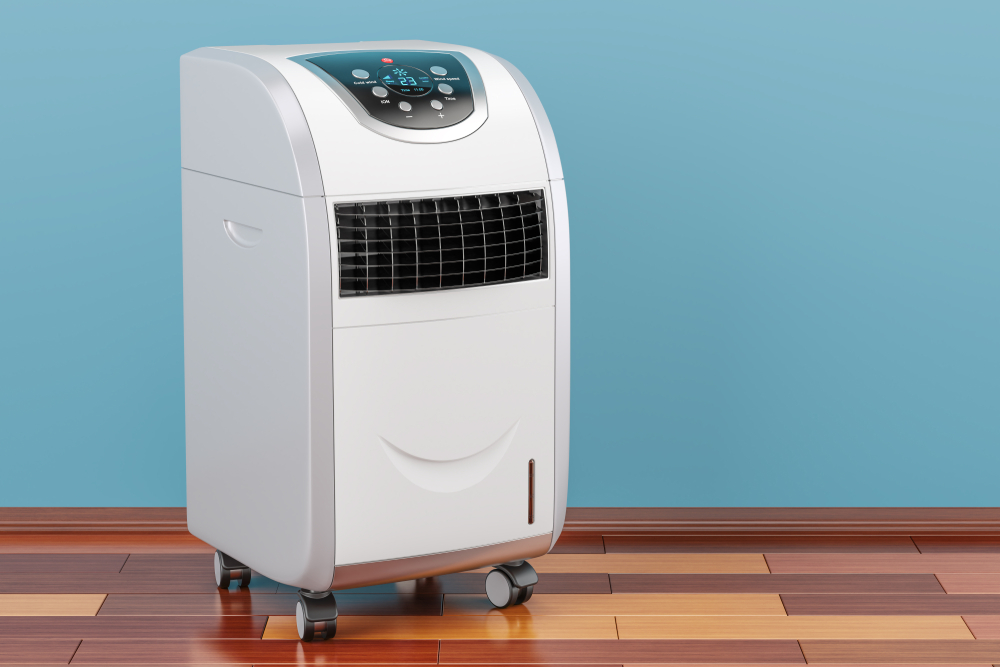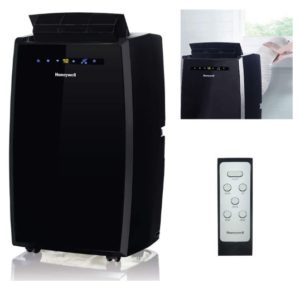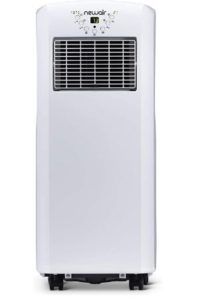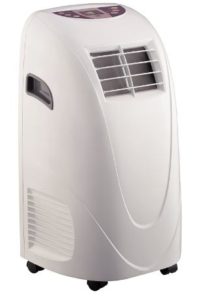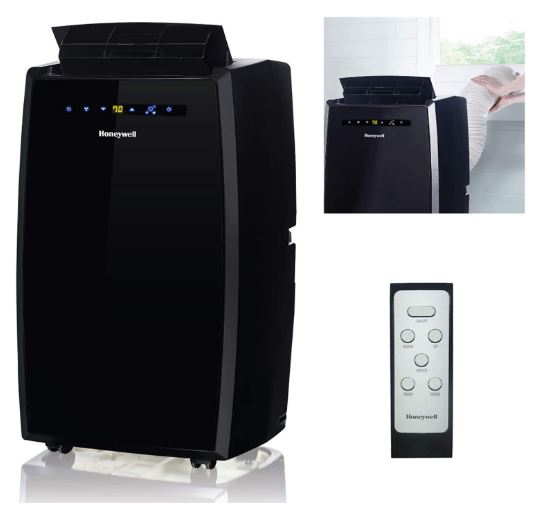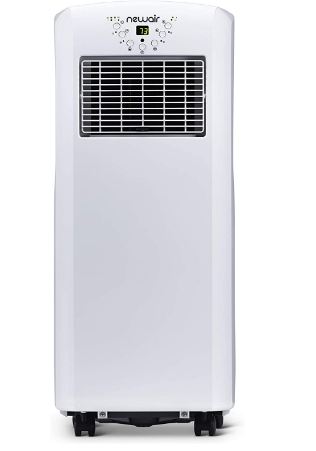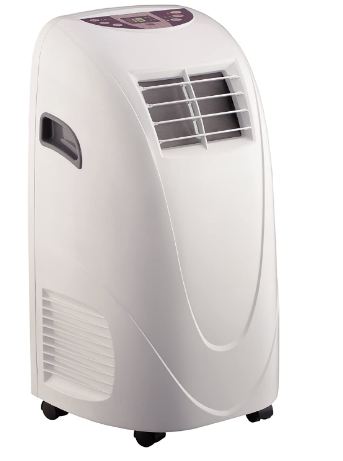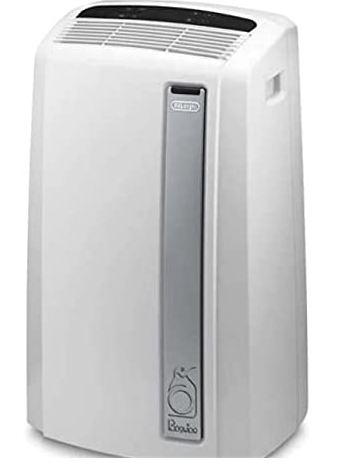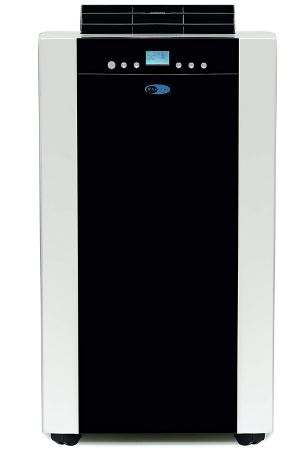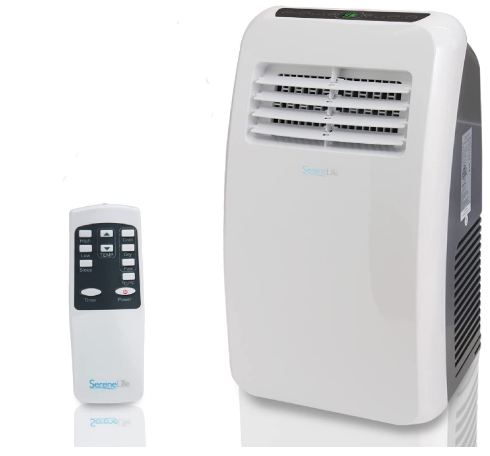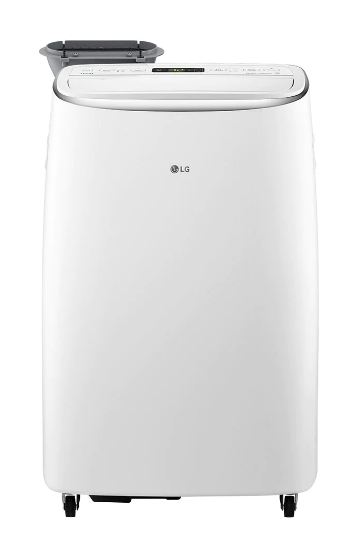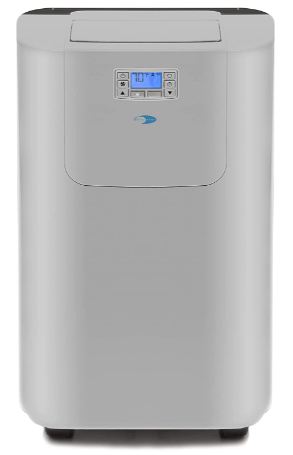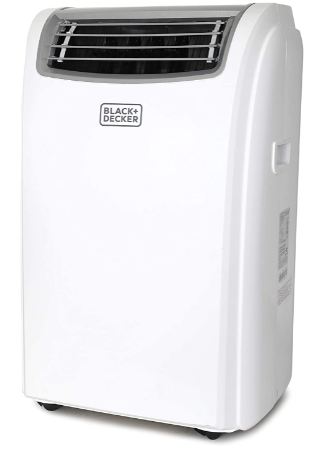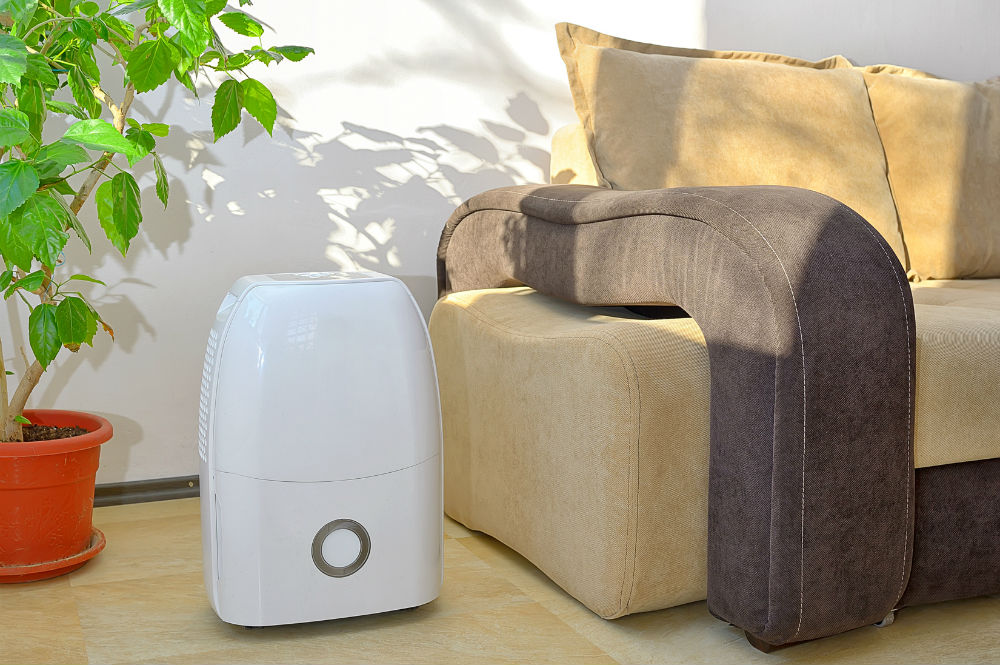Looking for a portable air conditioner to cool your home?
You’ve come to the right place.
Portable air conditioners range from hand-carried units to use in a bedroom or small office to larger semi-permanent units that can cool multiple rooms.
When choosing the best portable air conditioner for your room, there are a few key things you need to consider beyond brand and price.
For example, it might seem tempting to buy the largest air conditioner/BTU rating that you can afford or buy the smallest, thinking it will save you money.
But neither of these options is a wise one.
It is always best to short-list a few units with the right BTU rating for the size of the room you are trying to cool; then, consider other practicalities such as:
- how the unit ventilates waste heat from the room – single or dual hose?
- how quiet you need the system to be (decibels)
- how water condensation is removed – removable tray or hose?
- installation: will you ventilate exhaust heat through a window, door, or wall?
Portable Air Conditioners: Pros and Cons
While definitely not for every situation, portable air conditioners offer several advantages over central AC systems.
For example, they are portable, more cost-efficient, and use less energy overall.
That said, portable air conditioners are not a suitable replacement for a whole-home central HVAC system in most climates.
These units are very useful, however, in reducing energy consumption and improving your comfort when only one room such as your bedroom or home office needs to be cooled most of the day.
Portable AC units are also an excellent choice for cooling (and heating) cabins, sheds, garage offices, and other small buildings that are used occasionally.
Pros
1. Affordable
Central air conditioners cost thousands of dollars, but portable ACs are only $500. They start around $250-$300 and are the most affordable. Prices for 14,000 BTU coolers range from $400 to $500.
Portable coolers are a great deal because there is no cost for installation.
2. Portable
These coolers are very portable. Most portable air conditioners are indeed quite heavy – not lightweight in the sense that you can lift them on your own and move them to another room.
Portable coolers, however, are lighter than other air conditioning systems.
The majority of units weigh between 40-80 pounds, with some units weighing over 100 pounds.
Portability is a great advantage when you need to cool multiple rooms at once. You can wheel it to the living area in the morning and the bedroom at night.
3. Minimal Installation
Portable air conditioners don’t require any ductwork. You don’t need to tear down walls or damage your ceiling. It is tedious work, but setting up ducts or vents can also cost extra.
Installing portable air conditioners is simple. For most units, you can do it yourself. First, you need to follow the instructions on how to install the exhaust hose.
You only need to connect a water-cooled unit to a source of water. For example, almost no installation is required if you have an evaporative coolant or portable fan.
4. Low Maintenance Cost
Minimal installation also means less maintenance.
A traditional central air conditioner requires regular maintenance of the ductwork to keep it in good condition.
Portable air conditioners don’t use ductwork and are therefore easier to maintain.
The majority of cleaning and maintenance required can be performed without hiring a technician, which saves you a lot over time.
5. More Energy Efficient
Although central air conditioners are getting more efficient, they still require a lot of power to keep an entire house cool.
A portable air conditioner cools only the area being used, which saves lots of energy.
In addition, the latest models are often Energy Star rated and extremely miserly in pulling power.
Cons
1. Can Be Noisy
The fans used in most portable air conditioners can be noisy at high speed, so look for models that make as little noise as possible.
Most modern units give off 50dB to 60dB of sound when running, which is less than the average conversation. The sound is typically white noise which some find soothing.
You can find some as low as 40dB, which could be important if you don’t like the sound of a fan while working or sleeping, for example.
2. Not for cooling multiple rooms.
Portable air conditioners like the popular Hisense 10,000 BTU model sold on Amazon are almost always limited to cooling one room or a small apartment.
If you need to cool multiple rooms or the entire house, go for a mini-split or central air conditioner.
You can also buy a portable AC for every room that requires cooling, but it’s likely you will end up using more energy than you would if you installed a central air system.
Our Top 3 Picks
- Continuous drainage option.
- Dual filters.
- Wheels for easy portability.
- Built-in dehumidifier.
- Self-evaporative
- You can set up continuous drainage for very humid conditions.
- Remote control
- Self-evaporative
- Affordable price.
What’s In This Guide
This buying guide will help you choose the right portable air conditioner for your home, garage, office, or room.
We start by recommending our top picks for several common needs and BTU/room sizes.
Then, we review and compare each of our top picks.
After the reviews, we provide a quick buying guide explaining the features and options to consider when selecting the best portable AC unit for your application.
So, let’s get to it!
10 Best Portable Air Conditioners
- 1. Quetest Portable Air Conditioner: Honeywell MN12CES 12,000 BTU
- 2. Best Small Portable AC: NewAir Ultra-Compact 10,000 BTU
- 3. Best 10,000 BTU Portable AC: Global Air 10,000 BTU
- 4. Best 12,000 BTU Portable AC: DeLonghi America Whisper Cool
- 5. Best 14,000 BTU Portable AC: Whynter ARC-14SH
- 6. Best 8,000 BTU Portable AC: SereneLife SLPAC8
- 7. Best Budget Portable Air Conditioner: Black+Decker BPACT08WT
- 8. Most Energy Efficient: LG LP1419IVSM Dual Inverter
- 9. Best Dual Hose Portable AC: Whynter Elite ARC-122DS
- 10. Best Portable Air Conditioner plus Heater: Black+Decker BPACT12HWT
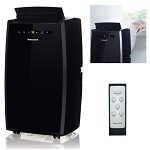
Honeywell MN12CES
Best Quiet Portable Air Conditioner
Noise:
MediumDrainage:
Self-EvaporationSize:
SmallBTU:
12,000
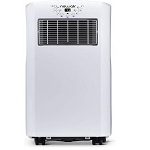
NewAir Ultra-Compact
Best Small Portable Air Conditioner
Noise:
LowDrainage:
Self-EvaporationSize:
SmallBTU:
10,000
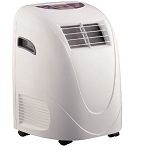
Global Air 10,000 BTU
Best 10,000 BTU Portable Air Conditioner
Noise:
HighDrainage:
Self-EvaporationSize:
SmallBTU:
10,000
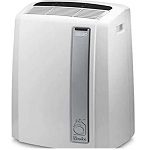
DeLonghi America Whisper Cool
Best 10,000 BTU Portable Air Conditioner
Noise:
LowDrainage:
Self-EvaporationSize:
MediumBTU:
12,000
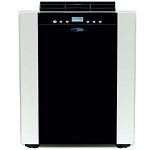
Whynter ARC-14SH
Best 14,000 BTU Portable Air Conditioner
Noise:
HighDrainage:
Auto-EvaporationSize:
MediumBTU:
14,000
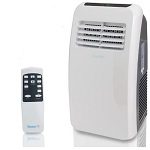
SereneLife SLPAC8
Best 8,000 BTU Portable Air Conditioner
Noise:
MediumDrainage:
Self-EvaporationSize:
SmallBTU:
8,000
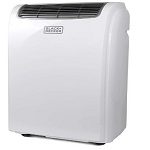
BLACK+DECKER BPACT08WT
Best budget portable air conditioner
Noise:
MediumDrainage:
Self-EvaporationSize:
SmallBTU:
8,000

LG LP1419IVSM
Best energy saving (up to 500 sq. ft.)
Noise:
LowDrainage:
Self-EvaporationSize:
MediumBTU:
14,000
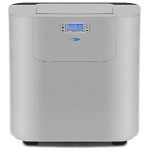
Whynter Elite ARC-122DS
Best dual hose portable air conditioner
Noise:
MediumDrainage:
Self-EvaporationSize:
MediumBTU:
12,000
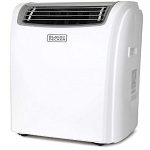
Black + Decker BPACT12HWT
Best portable air conditioner and heater
Noise:
HighDrainage:
Self-EvaporationSize:
MediumBTU:
12,000
Noise level is a major consideration when choosing a portable air conditioner.
Some units are quieter than others, but they often compromise air flow or other important features to accomplish that.
This 62 lb. unit emits a maximum decibel level of 55 dB.
PROS
- Quiet operation, even on highest speed.
- Continuous drainage option.
- Dual filters.
- Wheels for easy portability.
CONS
- A bit heavy.
Our Review
BTU
Honeywell MN12CES offers a cooling capacity of up to 12,000 BTU and a cooling surface of up to 400 square feet.
In addition, it features three fan speeds and a timer to turn off when you’re not there.
Ventilation
Honeywell MN12CES is a single-hose model and includes a window ventilation system. It takes only a few minutes from start to finish to install.
Drainage
The Honeywell MN12CES auto-evaporation system means that you don’t have to worry about moisture buildup.
Other Features
The Honeywell RN12CES has a remote control for easy operation from anywhere in the room.
You’ll also appreciate the touch controls on its LCD panel.
The unit also dehumidifies your room, removing up to 70 pints of moisture every 24 hours.
Portable air conditioners are meant to be portable, so it makes sense that they should stay on the small side of things.
In addition, the smallest units tend to blend better into a space, design-wise.
The AC-10100E Ultra-Compact from NewAir is a small portable air conditioner that offers both size and performance.
It measures 12.1×15.1×29.8 inches and weighs just over 60 pounds.
PROS
- Its compact design makes it great for small spaces.
- Built-in dehumidifier.
- Self-evaporative
- You can set up continuous drainage for very humid conditions.
CONS
- Spaces are limited or very small.
Our Review
BTU
The AC-10100E’s 10,000 BTU rating makes it ideal for cooling areas under 300 square feet. In addition, it takes up very little space.
Ventilation
This unit has a single hose and comes with a window installation kit that can fit windows up to 42 inches.
Drainage
The AC-10100E’s self-evaporative feature means that you don’t have to worry about removing moisture buildup. It’s not fully auto-evaporative, but it is close.
Other Features
The AC-10100E includes a 12-hour timer, sleep mode, and remote control. It also has an auto-fan function, which automatically maintains your chosen temperature by increasing and decreasing the fan speed.
While the Global Air 10,000 BTU unit may not include many features, it is very efficient and affordable.
It also blends well into any space while providing quiet operation.
PROS
- Cools quickly and efficiently despite its small size.
- Remote control.
- Self-evaporative
- Affordable price.
CONS
- It’s a little loud on high.
Our Review
Ventilation
Considering its size, it’s not surprising that this Global Air unit uses single-hose ventilation and comes with a standard window kit.
The manufacturer-recommended maximum cooling area is 400 sq. ft.
Drainage
Global Air is an excellent option if you don’t want to empty your unit.
Global Air uses a self-evaporative system that cools the condenser and recycles any condensation, meaning you don’t have to remove water from the system nearly as often.
Other Features
The Global Air features a 2-Speed cooling fan and a 4-way air direction. Digital controls allow you to control the unit from anywhere in the room.
The DeLonghi America PaCAN120EW 12,000BTU Whisper Cool Portable AC Conditioner is both quiet and powerful.
PROS
- Efficiently cools larger rooms
- Quiet operation
- Auto-evaporation minimizes water change
- Remote control for easy control from your couch (or bed).
CONS
- A bit large for a portable AC.
Our Review
Ventilation
This DeLonghi portable AC unit is ideal for small to medium-sized rooms, as it can cool up to 450 square feet.
The unit vents outside with a single hose measuring approximately 5 feet in length. However, it can be extended to 8 feet to provide additional space between the unit and the window.
Drainage
The DeLonghi America PACAN120EW evaporates condensing water by itself, recirculating it in the system.
Other Features
This system comes with many additional features that are worth mentioning.
The unit’s BioSilver filter traps bacteria and dust and prevents the growth of mildew and mold.
Whisper Cool reduces noise by approximately 50%. In addition, Real Feel controls humidity and temperature in the room.
The remote control allows you to operate the unit from anywhere in the room and can be stored easily at the top.
The sturdy casters also make it easy to move around.
Very few portable air conditioners deliver the level of cooling performance as the Whynter ARC-14SH.
This is especially true when you consider its affordable price.
PROS
- Cools larger areas
- All-year comfort with heating and cooling options
- Two air filters - a pre-filter and an activated carbon filter - improve indoor air quality
- High-capacity built-in dehumidifier removes up to 100 pints / day
CONS
- Not cheap.
- Included exhaust hose isn’t insulated and sometimes leaks heat.
Our Review
4-in-1 Portable AC
Unlike most portable air conditioners, the Whynter ARC-14SH is a portable air conditioner plus heater that can keep a large room or small apartment comfortable in all 4 seasons of the year.
This unit operates in two primary modes: heating or cooling.
The cooling range is 61°F – 89°F, and the heating range is 61°F – 77°F.
You also have a choice between fan-only or dehumidifier operation – the dehumidifier removes up to 101 pints per day from the air.
Ventilation
The dual-hose ventilation of the Whynter ARC-14SH is is required to maximize energy efficiency and balance the room’s temperature and air pressure, essential when cooling larger rooms.
Drainage
The Whynter ARC-14SH’s auto-evaporative system recycles any remaining condensation to cool its condenser and balance indoor humidity.
Other Features
This unit’s controls are simple and easy to use – including the remote control, which is used to set temperatures, fan speeds and preset timers.
The Whynter ARC-14SH also includes a washable filter that neutralizes odor.
A portable AC conditioner with a 8,000 BTU rating is ideal for smaller rooms.
This portable AC from SereneLife cools and humidifies up to 215 square feet.
PROS
- Ideal for small rooms.
- 3-in-1 functionality: Cool, Dry, & Fan
- Self-evaporative reduces water waste
- Timer & sleep mode.
- Casters for mobility.
- Remote control is simple to use
CONS
- A bit noisy on high
- Ventilation kit is fragile.
Our Review
3-in-1 Functionality
Like many other modern portable air conditioners, SereneLife’s SLPAC8 doesn’t just cool the room. The unit also features a built-in humidifier that extracts up to 1.2 liters of moisture every hour.
And don’t worry about frequent draining with the SereneLife portable AC. This model’s self-evaporative function removes moisture with the hot air.
That said, if you live in very humid area and run this system for days, you will need to drain your pan.
In addition to cooling and dehumidifying, you can also use the SereneLife AC as a fan to circulate the air around the room gently. Simply turn the fan-only setting on and choose your preferred speed.
Ideal for Compact Spaces
The SereneLife portable AC has a rating of 8,000 BTU, ideal for rooms up to 215 sq. feet. It’s great for a small bedroom, nurseries, home offices, and small living rooms.
Installation Kit Included
The SereneLife portable air conditioner, SLPAC8, comes ready to install with an installation kit.
But we think the vent hose is a little too flimsy.
Remote Control
You can adjust temperature and other settings using the touch control panel on the AC and on the included remote control.
Additional Features
The SereneLife SLPAC8 features a washable filter to keep out allergens and smooth-rolling casters that make it easy to transport.
We recommend the BLACK+DECKER BACT08WT portable AC for those who are on a tight budget. It’s a simple unit that cools small rooms up to 200 sq. feet quickly and efficiently.
PROS
- Affordable price.
- Ideal for small spaces.
- Self-evaporative function reduces water waste
- 3-in-1 functionality
- Timer and sleep mode.
CONS
- Can be loud on high.
Our Review
Cooler, Dehumidifier, and Fan
Black+Decker’s BPACT08WT portable air conditioner features a 3-in-1 design. You can use it to cool a room, dehumidify the air, or use it as a fan. You switch functions using the remote control or the on-unit control panel.
Ideal For Small Rooms
For spaces less than 200 square feet, the Black+Decker BPACT08WT has a cooling power of 8,000 BTUs.
It’s a simple and effective choice for a small bedroom, baby nursery, or home office.
The AC can be noisy, however, when the fan is turned to its highest speed.
That said, the AC makes a gentle fan noise at lower settings that is not loud. It is easy to get used to by most buyers, and some find it even soothing.
If you are looking for a peaceful sleeping environment, the Honeywell MN12CES is our top pick. You can also check out our reviews of the quietest portable air conditioners.
Self-Evaporative
For most people, Black+Decker’s BPACT08WT portable AC will not need to be emptied. It is self-evaporative, which means that any moisture it accumulates is expelled outside with the hot air.
Unless you live in a humid area and use the dehumidifier mode for a long period, the AC manages will probably get rid of all collected moisture. If the pan does fill up, use the included drain tube to empty it.
Remote Control
You can control the temperature and other settings using the included remote control without having to get up. You can change to dry, sleep, fan, or dry mode. In addition, the remote allows you to set a timer to turn off the AC and adjust the fan speed.
Filter
This portable AC filters the air to remove allergens and other pollutants.
The Black+Decker’s BPACT08WTdoes not really replace your air purifier, but it will improve indoor air quality.
You can also wash the filter, so replacement costs are low.
LG claims that their LP1419IVSM portable AC conditioner saves you up to 40% compared to other portable ACs.
The secret is its dual inverter technology.
The LG LP1419IVSM is also one of the quietest portable air conditioners we’ve seen, thanks to a specially-designed motor that takes advantage of the dual inverters.
PROS
- Lowest cost to run
- Very quiet operation
- WiFi connectivity: app control and smart assistant-compatible
- Great for large spaces
CONS
- A bit expensive.
Our Review
Dual Inverter Compressor Saves Energy
The LG LP1419IVSM has more technology than many portable air conditioners. So let’s begin with the most important, the dual-inverter compressor.
Compressors typically turn on when cooling is required and turn off when the temperature has reached the desired level. Thus, there are only two modes: on and off.
In contrast, inverter compressors drive a variable speed motor to meet cooling demand in a more analog fashion. This saves energy as the motor does not have to run at its maximum speed.
As a result, the compressor on this LG portable AC unit offers more efficient cooling and lowers energy consumption.
Quiet Operation
The dual-inverter compressor has another advantage: it runs quieter and produces almost no vibrations compared to a single-inverter compressor.
This unit is notably quiet for a portable AC this size.The noise level at the highest fan speed is approximately 52dB. This is less than many portable ACs that run at a lower fan speed.
If you switch to the lowest fan speed, and the noise level drops to a whisper-quiet 44dB, perfect for bedside or keeping sleeping baby cool.
Cooling and Dehumidification
The LG LP1419IVSM is rated at rather powerful 14,000 BTU, suited for rooms of up to 500 square feet in size such as a large bedroom, game room, en suite, or living room.
You can also use the LG LP1419IVSM to dehumidify a room.
And due to its self-evaporative function you won’t have to drain the AC unless it is very humid inside.
Remote Control
You can adjust the temperature, speed of the fan, change to sleep mode, or set a timer right from your couch’s comfort. You can also use the control panel located at the top of your AC.
WiFi Connectivity
In addition, the LG AC conditioner is WiFi-enabled and smart home compatible, which gives you two additional control options not found in most portable AC units.
The first new method: you can control the AC over your home WiFi connection using the SmartThinQ smartphone app. This includes setting temperature, changing modes, and switching the AC on and off from anywhere.
And the app works… which is better than most other smart air conditioners we have reviewed with terrible clunky apps.
We have no complaints about the app dropping connections or crashing, either. Some people have complained that the app loads slow, however.
You can also control the LG LP1419IVSM by voice using Google Assistant or Amazon Alexa.
In addition, you can use your smartphone or a smart speaker to send voice commands.
Because of the many control options, it is easy to integrate the LG L1419IVSM into a smart home.
The LG LP1419IVSM does not work with Apple Siri or HomeKit, however.
PROS
- Dual hose design cools quickly and efficiently.
- The unit is not too loud - most people can sleep well with it on.
- Auto drainage.
- Remote control.
- Programmable auto-on/off timer
CONS
- More expensive than single-hose ACs of similar BTU.
- It is difficult to climb and descend the stairs.
Our Review
A portable AC with a dual hose will cool a room faster than a single hose unit.
The Whynter Elite ARC-122DS portable AC with 12,000 BTU cooling power is one of the most efficient dual hose ACs we’ve reviewed.
Double Hose
Although you won’t see it, using two hoses makes a portable AC far more efficient than a standard single-hose.
Verified customers who upgraded to this unit from a single hose AC say that they immediately noticed much more cooling.
The dual-hose design on the Whynter Elite ARC-122DS is beneficial in hot weather when it’s necessary to cool down a room quickly. This is also great for cooling larger rooms.
It is easier to set up dual hose AC than a single hose unit. And don’t worry, a dual-hose unit will still fit into a standard window.
12,000 BTU with Three Modes
The Whynter Elite ARC-122DS is rated at 12,000 BTUs making it suitable to use rooms up to 400 sq. feet.
The AC operates in three modes: normal cooling mode, dehumidification mode, or fan-only mode.
You can set the temperature you prefer on the remote control or screen, and the unit will keep it.
Powerful Dehumidification
The Whynter Elite ARC-122DS is an excellent option if you live in a humid area.
The dual hose design of this unit allows it to extract a lot of water from the air, up to 76 pints daily.
Most people won’t have to drain the AC, as all water is exhausted outside in the form of water vapor. However, if it’s really humid, you may need to drain the capture tray manually.
Programmable On/Off Timer
You can use the remote to set the Whynter Elite to turn on or off after a certain amount of time.
The AC runs only when needed, which reduces energy consumption and improves comfort.
You can set the AC to start cooling the living room before you get home or have it turn off a couple of hours after you sleep, so it doesn’t get too cold.
If you are looking for a portable air conditioner you can use all year round, we recommend the 4-in-1 Black+Decker BACT12HWT portable air conditioner and heater.
It is a perfect solution for heating, cooling, and dehumidifying smaller rooms.
PROS
- Four modes: heat, cool, fan, and dehumidify.
- Remote control.
- Also includes an energy-saving auto mode.
- Auto drainage.
- Includes swing and timer functions.
CONS
- Noisy.
- It is heavy and difficult to lift up and down the stairs.
- Not recommended for large rooms.
Our Review
Dual Inverter Compressor Saves Energy
The LG LP1419IVSM has more technology than many portable air conditioners. So let’s begin with the most important, the dual-inverter compressor.
Compressors typically turn on when cooling is required and turn off when the temperature has reached the desired level. Thus, there are only two modes: on and off.
In contrast, inverter compressors drive a variable speed motor to meet cooling demand in a more analog fashion. This saves energy as the motor does not have to run at its maximum speed.
As a result, the compressor on this LG portable AC unit offers more efficient cooling and lowers energy consumption.
Quiet Operation
The dual-inverter compressor has another advantage: it runs quieter and produces almost no vibrations compared to a single-inverter compressor.
This unit is notably quiet for a portable AC this size.The noise level at the highest fan speed is approximately 52dB. This is less than many portable ACs that run at a lower fan speed.
If you switch to the lowest fan speed, and the noise level drops to a whisper-quiet 44dB, perfect for bedside or keeping sleeping baby cool.
Cooling and Dehumidification
The LG LP1419IVSM is rated at rather powerful 14,000 BTU, suited for rooms of up to 500 square feet in size such as a large bedroom, game room, en suite, or living room.
You can also use the LG LP1419IVSM to dehumidify a room.
And due to its self-evaporative function you won’t have to drain the AC unless it is very humid inside.
Remote Control
You can adjust the temperature, speed of the fan, change to sleep mode, or set a timer right from your couch’s comfort. You can also use the control panel located at the top of your AC.
WiFi Connectivity
In addition, the LG AC conditioner is WiFi-enabled and smart home compatible, which gives you two additional control options not found in most portable AC units.
The first new method: you can control the AC over your home WiFi connection using the SmartThinQ smartphone app. This includes setting temperature, changing modes, and switching the AC on and off from anywhere.
And the app works… which is better than most other smart air conditioners we have reviewed with terrible clunky apps.
We have no complaints about the app dropping connections or crashing, either. Some people have complained that the app loads slow, however.
You can also control the LG LP1419IVSM by voice using Google Assistant or Amazon Alexa.
In addition, you can use your smartphone or a smart speaker to send voice commands.
Because of the many control options, it is easy to integrate the LG L1419IVSM into a smart home.
The LG LP1419IVSM does not work with Apple Siri or HomeKit, however.
Types of Portable Air Conditioners
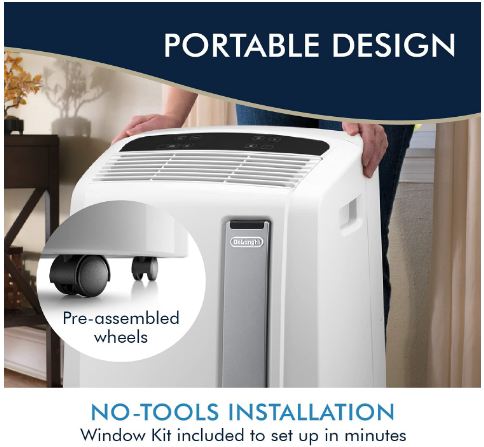
1. Mini-Split (ductless)
Mini-split air conditioners fall somewhere in between central homes and portable coolers. Although it is larger and takes more work to install, it lacks the power of central air conditioners.
Mini-split air conditioners are typically single-room coolers that are easy and convenient to move around from room to room. Therefore, we lump them together with portable air conditioners.
A mini-split air conditioner is made up of two main units. The first unit is located inside the house, while the second is on the outside. These two units are connected by a narrow line that passes through the wall, and the only thing needed to connect them is a small hole.
The outdoor unit, also known as the “engine,” contains various components like a compressor and condenser. Its job is to remove heat from the room. The indoor unit, located on the floor, wall, or ceiling, removes warm air from the room and blows in cooler air.
Mini-split systems are often used to cool multiple rooms, and the main outdoor unit connects to the indoor units in different rooms.
Pros
- Mini-split ACs provide both heating and cooling.
- Often large enough to cool multiple rooms.
- Easier and cheaper to install than central ACs.
Cons
- Not as portable as smaller units.
- Most expensive type of portable air conditioner.
2. Hot Air Exhaust System
This is the most common type of portable air conditioner.
Exhaust ACs remove heat from the room air flowing through the unit and transfer the heat to another stream of air flowing past a heat exchanger. The host exhaust air is then blown outside to dissipate.
The exhaust air must have a way to make it outside via one of two ventilation methods: single or double hose.
Depending on the design, a hot air exhaust system can be ventilated through a window, door, or even a wall.
Pros
- Great climate control.
- Lightweight and portable.
- Advanced scheduling, programming, and smart home features are common.
Cons
- Require ventilation.
- Not as energy efficient as central air conditioners.
3. Water-Cooled Air Conditioners
A portable water-cooled air conditioner is an excellent alternative to hot air exhaust system – it can be used inside enclosed spaces that don’t have access to outside ventilation.
In a water-cooled air conditioner, warm inside air blows across to a water-cooled heat exchanger where water removes heat from the air before it is blown back into the room.
Heat is continuously removed from blowing air by constantly replacing the warm water with cooler water.
The warmed water is sent outside into the sewage system, typically using a hose.
Cooler fresh water is supplied from your home’s potable water supply.
Pros
- No exhaust ventilation required.
- More energy-efficient than hot air exhaust ACs.
- Better choice for hot and humid conditions.
Cons
- Requires access to a water source and a drain.
4. Evaporative Coolers
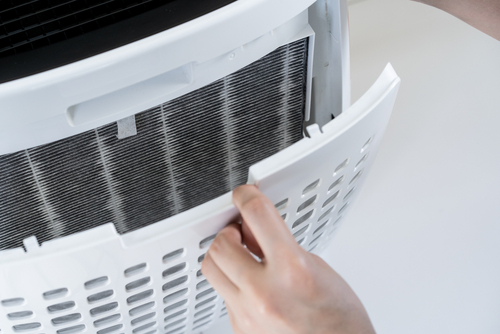
Portable evaporative coolers also use water to cool a room.
However, they don’t need to connect to a water like water-cooled units do.
Instead, you’ll need to fill a water reservoir and keep adding more water as needed.
Air cooling is done via evaporation. Fan-forced inside air is blown over the water, causing the water to evaporate and to absorb heat from the air before the air is blown back into the room.
Portable evaporative coolers are also great for enclosed spaces without ventilation options because they don’t require venting or connection to water lines and drains.
This kind of portable air conditioner is great to use in warm and dry climates. In fact, the unit’s efficiency will increase as the air is warmer and drier.
Pros
- Completely self-contained - no water lines or exhaust hoses required.
- Very simple - and inexpensive.
- Great choice for hot, dry climates. Including outside.
Cons
- Regular water refills are required.
- Not a good choice for humid climates.
5. Fans
Although not technically air conditioners, portable fans can provide a nice cooling effect in small or mid-sized rooms in the right climates.
In addition, fans are cheaper to operate than portable air conditioners and don’t require complex installation. Just plug it in and go.
Pros
- Cheap to operate
- Simple installation
- Portable and easy to use
Cons
- Cooling effect is minimal in most situations.
- High air flow be annoying - and noisy.
Buying Guide: How To Choose the Best Portable Air Conditioner

Each room is different, so that cooling energy requirements may vary depending on the climate.
Select the Right BTU For Your Room Size
These and other practical reasons mean it is difficult to calculate exactly how many British Thermal Units (BTUs) you need for a particular room.
But you can get close enough to ensure you end up with the right-sized unit.
Portable air conditioner manufacturers know that customers cannot accurately calculate BTU requirements, so they design systems to meet various needs and sizes.
When picking a portable air conditioner for a room, the rule of thumb is that it needs about 20 BTU for each square foot of floor space you are cooling.
For a calculation of your square footage, multiply the room’s longest length by its longest width.
If your room is complex or irregularly shaped, you need to divide it into multiple rectangular sections. Then calculate the footage for each section.
You can also ask your real estate agent or developer for help in calculating the room size. Most likely, they have the exact size of your room in their official records.
Here is a rough estimate of how many BTUs are needed to cool three different sizes of common rooms:
* 300 sq. ft or less: 10,000 BTU
* 300-500 square feet: 10,000-14,000 BTU
* Over 500 sq. ft: More than 14,000 BTU
Note: Many portable air conditioners now come with two BTU ratings. The first is the older ASHRAE rating, while the second is a lower Department of Energy rating. This does not mean that the unit has two cooling capacities. Instead, it is the same cooling performance.
These ratings reflect the newer DOE efficiency standards applicable to portable air conditioners.
Adjusting the BTU Rating for Special Conditions
You should also consider a few other factors. For example, the following factors have an impact on the BTU rating:
- Increase the BTU required if the ceiling is higher than 8 feet.
- Reduce the BTU rating by 10% if your space is very shaded.
- Increase the BTU capacity by 10% if your space is bright and sunny.
- Add 600 Btu to each individual if more people than two will be occupying the space.
- Increase the capacity by 4,000 BTU if the unit is used in a kitchen or server room.
Any space with anything that makes it warmer than a standard area or increases the volume of air that must be cooled will require more BTUs and the standard calculation.
These guidelines help you choose the best portable air conditioner to fit your space.
There are other factors to consider
Ventilation
All portable air conditioners must vent hot air from the area being cooled as part of the cooling procedure.
The hot air needs to be directed out of the room, or you’ll simply be pumping hot exhaust right back into the room and defeating the purpose of the unit.
Types of Ventilation Systems
Two types of portable air conditioner ventilation systems are available: one-hose or double-hose.
One-hose portable air conditioner units draw warm air from the room, cool it down, and then return most of the cooled air back to the room.
A portion of the intake air gets siphoned off and used to draw heat from the air conditioner’s fan. The air conditioner’s single exhaust pipe then vents it outside.
The dual-hose portable conditioner draws in air from the outside, cools it, and then releases it back into your home. In addition, the unit transports heat from the evaporator unit using 100% outside air.
The first hose draws in air from the outside, cooling the unit. The hot exhaust air is then vented outside through the second.
Dual-hose units don’t create negative pressure in rooms like single-hose models. They are also more efficient than single-hose units so you can cool larger spaces faster with it.
A dual-hose portable air conditioner has one drawback: some models have two internal fans. This can result in more noise and greater energy consumption.
Ventilation Location
When buying a portable conditioner, it is essential to choose a unit that works with the specific ventilation options available in your room.
A majority of units can vent outside air through a window or door. However, sometimes you may need to do some installation.
Windows
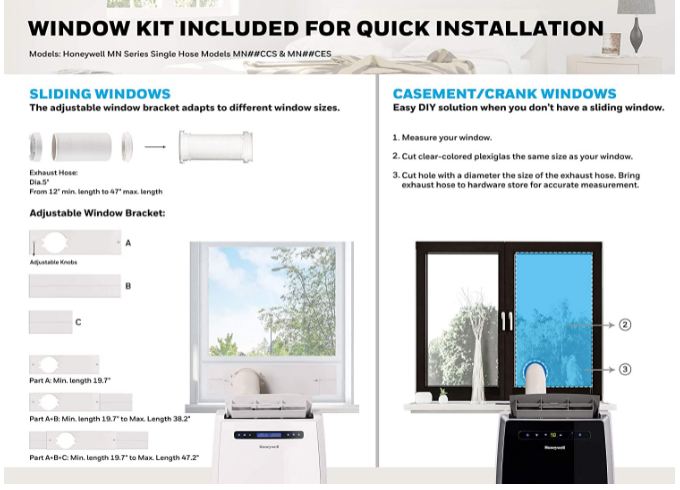
A majority of portable air conditioners include a window kit that allows you to vent outside. This kit comes with either one or two vent pipes, a bracket, and some adapters.
It is usually very simple to install. You simply need to open the window enough for the bracket to fit in and then close the window to seal it off. The hose connects to the bracket and allows for airflow outside.
It is easy to move the unit from one location to the next, provided you have a window within reach of the vent hose.
Doors
If you have a larger space, it is possible to install a ventilation bracket and a sliding door.
It’s the same idea as installing windows, but you might need to use a special kit or extra brackets to make it work.
Walls
Others may prefer to direct hot air through a wall, outside, or another room or area of the house, such as a garage or storage space.
It takes some planning and creativity to get through a wall, but you can usually do it with a jigsaw or some carefully placed measurements. Take a look at the gallery below to get an idea of what we mean.
Whatever ventilation method you use, make sure your unit is properly ventilated. Without it, portable air conditioners can’t do their job.
Features and Options To Consider
The highest quality portable air conditioners are available in many different models and provide more control and flexibility over their operation.
Programmability
People want more than power on and off.
Programmable features allow you to program the unit to operate at specific temperatures and airspeeds. This is especially useful if you want to adjust the unit’s noise level or set the temperature and time for the conditioner to operate.
Electric Strips
Some units include an electrical strip built into the unit to plug in additional cords or devices. This can be very handy.
Heat Pump
You can heat or cool a room in winter by purchasing units with a heat pump.
A heat pump is an excellent option for those who are in very dry climates or need to keep things comfortable between seasons, because they can alternate from heating to cooling depending on the time of day.
Dehumidifier
Many portable air conditioners also double as a dehumidifier, giving you a two-in-one appliance that can save you money and energy, especially when in an area such as a basement.
To some extent all portable air conditioners act as dehumidifiers, but some models have a unique setting that allows them to function purely as a dehumidifier..
Noise Level
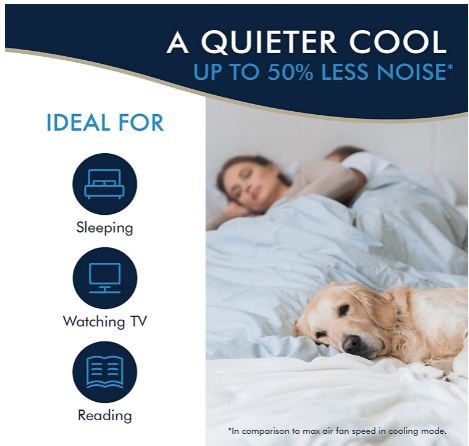
Most portable air conditioners are not silent.
Depending on the location of your unit, the decibel noise level and the quality of the sound emitted can be very significant when deciding on the best portable air conditioner for your room.
If you plan on using the unit in a living room or dining room area, the noise level should be as low as possible.
The bedroom decibel level is not as important as the type and frequency of the noise.
People like to sleep with what is known as white noise, which many portable air conditioners produce.
Anything in the 50-56dB range is fine if you don’t mind a soft hum.
You might want something quieter, perhaps in the high 40s.
Even though they are usually more expensive, you can find some with a ~40dB noise rating.
Drainage Options
Portable air conditioners are often used to cool humid, warm air.
However, they also remove water from the air, so water condensation builds up inside every unit and must be removed.
There are 5 different solutions provided by portable ACs to deal with condensation, and each has its pros and cons. It’s important for you to choose which kind makes the most sense for your space, behavior and needs.
1. Fully Self-Evaporative
The portable, self-evaporating air conditioner removes any condensate built up by combining it with the hot exhaust air, eliminating the need to drain or dump water.
This is the best choice if you don’t want to leave your unit unattended. However, fully evaporative portable air conditioners are not recommended for high humidity environments. So, before you purchase, make sure to check the relative humidity range.
2. Partially Self-Evaporative
Partially evaporative units can evaporate most of the moisture into their own hot air exhaust, resulting in little to no water to empty on your own. The amount of drainage or tray dumping required depends on the usage time and environmental conditions of the area being cooled.
3. Gravity Drain/Drain Hose
Most portable air conditioners have the option of a permanent water drain hose connection to ensure that any water condensation is drained outside. In addition, most drain tubes direct the water to a nearby floor drain.
4. Condensate Pumps
A separate accessory is the condensate pump. Condensate pumps are an accessory that helps drain the water from the drain hose. If you want to cool down a basement, the hose can be routed up and through a window.
5. Trays or Buckets
The simplest portable air conditioners have an internal container to collect extra water. However, these trays or buckets need to be dumped out regularly during their use.
Reliability
This is crucial.
It is disappointing to spend hundreds of dollars on something that doesn’t work when you really need it.
Make sure your portable air conditioner has lots of verified customer reviews to give you an accurate idea about how reliable it is. We recommend only considering units that have been on the market for over a year and have more than 20-30 verified reviews on the web.
A long and strong warranty is another sign of reliability, because it is a sign of the manufacturer’s trust in their product.
Most manufacturers offer a standard warranty of one year. But some units offer 2.
Ease of Use
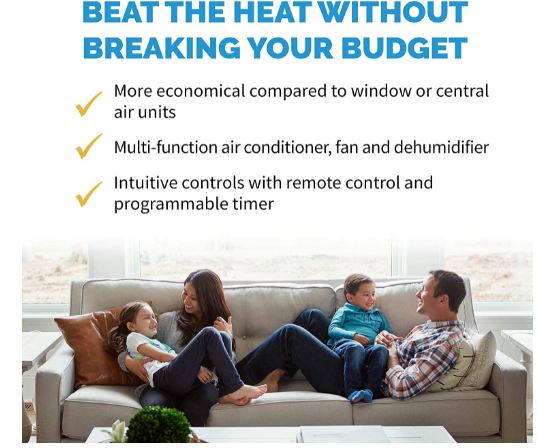
This is what most people forget to consider when purchasing a portable air conditioner: how easy will it be for them to set up and use the dang thing, given their unique situation?
Many customers will buy a portable AC after a minute or two of research – then immediately complain about confusing setup procedures, unclear instructions from the manufacturer, the need to use an exhaust hose and drain hose, or general frustration with the unit.
Portable air conditioners are easy enough to install on your own with no special tools.
And after installation, they are really easy to use.
The best portable ACs today offer a remote control that lets you control, program, and adjust settings.
We think smartphone apps aren’t worth the hassle for most people.
And while smart home / intelligent assistant connectivity is cool, we think it’s kind of overkill for something you want to set and forget.
Water-Cooled vs. Dehumidifying (Air-Cooled)
There are two main types of portable air conditioners available: air-cooled/dehumidifying and water-cooled.
Your local and room climate will mostly determine which type of portable air conditioner is best for you.
Portable air conditioners that are water-cooled or water-evaporative work best in dry environments.
For humid climates, air-cooled air conditioners are the best choice. This is because they provide both cooling and dehumidifying functions.
How We Rate Portable Air Conditioners
The following specifications and features are included in our 5-star rating system.
Customer Reviews
The third-party verified owner reviews are given a lot more weight than model reviews. To be considered for our shortlist, a model must have at least a 3.5-star rating on one major consumer review site or retailer site, and products with more than 12 ratings on multiple sites are given priority.
BTU vs. Price
This is the most critical aspect of evaluating a unit. A unit with a higher BTU rating almost always comes at a higher cost and usually has a few extra features. Therefore, units that offer the most BTU per dollar are our favorite.
Noise
A portable air conditioner can be the coolest, most feature-rich unit on the market, but it will go down on our overall rating if it’s too loud and noisy. The quietest units can operate at an acceptable level (77db on maximum settings) and a very quiet when set on low or medium fan speeds (55-60db).
Fans aren’t the only components that contribute to an AC unit’s noise level because the compressors also play quite a significant role in making AC units loud.
Weight
The lighter the unit, the easier it is to transport. No one wants to have to deal with a heavy air conditioner. It should be easy to move around your home, so it is worth having a lighter weight.
Price
We believe in paying what you get. Therefore, we won’t consider a unit worth its price if it doesn’t reflect its true value.
Ventilation
Dual-hose models are more preferred than single-hose models due to their efficiency and lack of backpressure issues. However, most ACs are single-hose.
Drainage
We prefer units with an auto-drain function, which removes humidity from the room and does not require drainage tubes, buckets, or trays. However, 100% auto-evaporative exhaust often leads to a higher noise level and lower energy efficiency.
However, keep in mind that even an AC portable with an auto drain function might need manual draining if there is too much humidity in the area. That’s why most portable ACs have a manual drain port and a drain line.
Features
While some extra features are not necessary to make the unit more efficient, others play a significant role in its overall functionality, usability, and ease of use. For example, a remote control, fan speeds, and additional features such as heating or dehumidifying are all great ways to make a unit stand out.
How to Install a Portable AC Conditioner
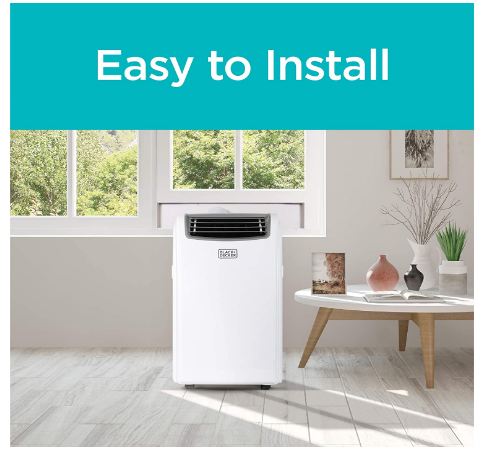
Portable air conditioners don’t require extensive installation, and most can easily be installed by anyone without any additional professional assistance.
Installation procedures vary from one brand to the next. The instruction manual that came with the portable cooler is your best source of guidance. If this fails, you can contact customer service.
If you are planning to purchase the traditional window-vented portable cooler, make sure it comes with a venting kit that can be used with a window, door, or wall. Window and door kits are the easiest to install.
Wall ventilation requires a little more effort as you must drill through the wall to get the right size hole.
Venting is not required if you plan to purchase a portable, water-cooled air conditioner. However, you need to install a water supply and drain. To properly set up and install the air conditioner, refer to the manual provided by the manufacturer.
No matter how you install your AC, make sure there is enough space around it to allow for air circulation.
I’m a degreed ME (mechanical engineer) who is passionate about machines of all kinds. I created MachineWonders.com as a way to connect with others who love machines like me – or need help choosing one for their needs, application, or situation.

